标签:des style blog http ar io color os 使用
java IO
以pathname为路径创建File对象,可以是绝对路径或者相对路径,如果pathname是相对路径,则默认的当前路径在系统属性user.dir中存储。
以parent为父路径,child为子路径创建File对象。
常见方法:
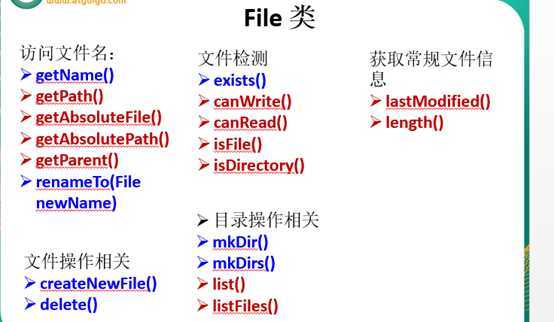
eg:
File dir1 = new File("D:/IOTest/dir1"); if (!dir1.exists()) { // 如果D:/IOTest/dir1不存在,就创建为目录 ????dir1.mkdir(); } // 创建以dir1为父目录,名为"dir2"的File对象 File dir2 = new File(dir1, "dir2"); if (!dir2.exists()) { // 如果还不存在,就创建为目录 ????dir2.mkdirs(); } File dir4 = new File(dir1, "dir3/dir4"); if (!dir4.exists()) { ????dir4.mkdirs(); } // 创建以dir2为父目录,名为"test.txt"的File对象 File file = new File(dir2, "test.txt"); ???? if (!file.exists()) { // 如果还不存在,就创建为文件 ????file.createNewFile();} |
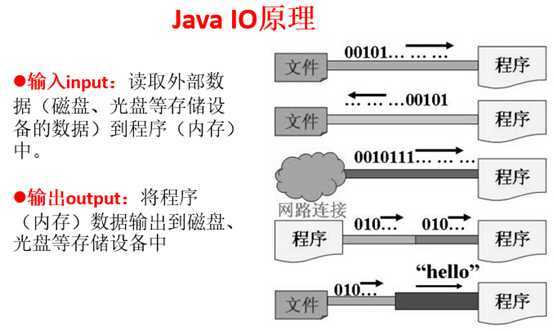
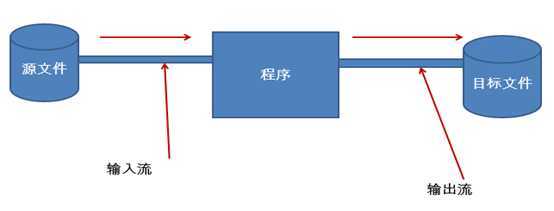
(抽象基类) | 字节流 | 字符流 |
输入流 | InputStream | Reader |
输出流 | OutputStream | Writer |
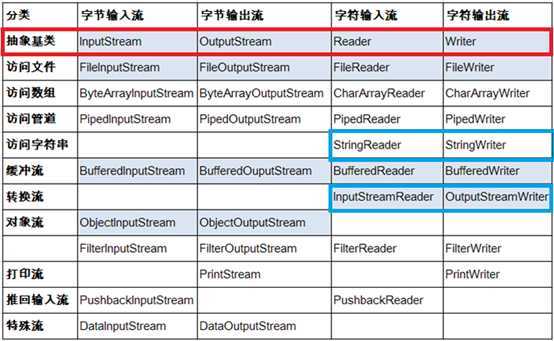
读取文件
1.建立一个流对象,将已存在的一个文件加载进流。
2.创建一个临时存放数据的数组。
3.调用流对象的读取方法将流中的数据读入到数组中。
FileReader fr = null; ????try{ ????????fr = new FileReader("c:\\test.txt"); ????????char[] buf = new char[1024]; ????????int len= 0; ????????while((len=fr.read(buf))!=-1){ ????????????System.out.println(new String(buf ,0,len));} ????}catch (IOException e){ ????????System.out.println("read-Exception :"+e.toString());} ????finally{ ????????if(fr!=null){ ????????????try{ ????????????????fr.close(); ????????????}catch (IOException e){ ????????System.out.println("close-Exception :"+e.toString()); ????????????} } } |
?
写入文件
1.创建流对象,建立数据存放文件
2.调用流对象的写入方法,将数据写入流
3.关闭流资源,并将流中的数据清空到文件中。
FileWriter fw = null; ????try{ ????????fw = new FileWriter("Test.txt"); ????????fw.write("text"); ????} ????catch (IOException e){ ????????System.out.println(e.toString()); ????} ????finally{ ????????If(fw!=null) ????????try{ ???????? fw.close(); ????????} ????????catch (IOException e){ ????????????System.out.println(e.toString()); }???? } |
?
注意点:
?
?
BufferedReader br = null; BufferedWriter bw = null; try { ????//step1:创建缓冲流对象:它是过滤流,是对节点流的包装 ????br = new BufferedReader(new FileReader("d:\\IOTest\\source.txt")); ????bw = new BufferedWriter(new FileWriter("d:\\IOTest\\destBF.txt")); ????String str = null; ????while ((str = br.readLine()) != null) { //一次读取字符文本文件的一行字符 ????????bw.write(str); //一次写入一行字符串 ????????bw.newLine(); //写入行分隔符 ????} ????bw.flush(); //step2:刷新缓冲区 } catch (IOException e) { ????e.printStackTrace(); } finally { // step3: 关闭IO流对象 try { ????if (bw != null) { ????????bw.close(); //关闭过滤流时,会自动关闭它所包装的底层节点流 ????} } catch (IOException e) { ????e.printStackTrace(); } try { ????if (br != null) { ????????br.close(); ????} } catch (IOException e) { ????e.printStackTrace(); ????} } |
如: Reader isr = new
InputStreamReader(System.in,"ISO5334_1");//指定字符集
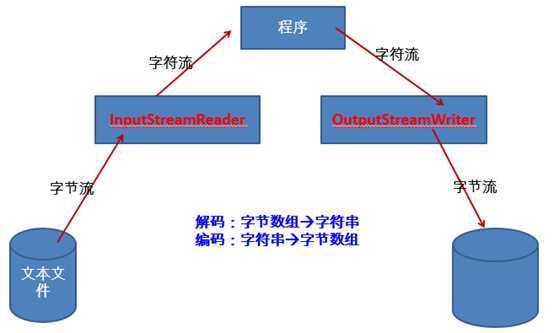
public void testMyInput() throws Exception{ FileInputStream fis = new FileInputStream("dbcp.txt"); FileOutputStream fos = new FileOutputStream("dbcp5.txt"); InputStreamReader isr = new InputStreamReader(fis,"GBK"); OutputStreamWriter osw = new OutputStreamWriter(fos,"GBK"); BufferedReader br = new BufferedReader(isr); BufferedWriter bw = new BufferedWriter(osw); String str = null; while((str = br.readLine()) != null){ bw.write(str); bw.newLine(); bw.flush(); } bw.close(); br.close();} |
计算机只能识别二进制数据,早期由来是电信号。为了方便应用计算机,让它可以识别各个国家的文字。就将各个国家的文字用数字来表示,并一一对应,形成一张表。这就是编码表。
?
System.out.println("请输入信息(退出输入e或exit):"); //把"标准"输入流(键盘输入)这个字节流包装成字符流,再包装成缓冲流 BufferedReader br = new BufferedReader( ????new InputStreamReader(System.in)); String s = null; try { ????while ((s = br.readLine()) != null) { //读取用户输入的一行数据 --> 阻塞程序 ????????if (s.equalsIgnoreCase("e") || s.equalsIgnoreCase("exit")) { ????????????System.out.println("安全退出!!"); ????????????break; ????????} ????????//将读取到的整行字符串转成大写输出 ????????System.out.println("-->:"+s.toUpperCase()); ????????System.out.println("继续输入信息"); ????}???? } catch (IOException e) { ????????e.printStackTrace(); } finally { ????try { ????????if (br != null) { ????????????br.close(); //关闭过滤流时,会自动关闭它包装的底层节点流 ????????}???? ????} catch (IOException e) { ????????e.printStackTrace(); ????}???? } ? ???????? |
?
FileOutputStream fos = null; ????try { ????????fos = new FileOutputStream(new File("D:\\IO\\text.txt")); ????} catch (FileNotFoundException e) { ????????e.printStackTrace(); ????}//创建打印输出流,设置为自动刷新模式(写入换行符或字节 ‘\n‘ 时都会刷新输出缓冲区) ????PrintStream ps = new PrintStream(fos,true); ????if (ps != null) {????// 把标准输出流(控制台输出)改成文件 ????????System.setOut(ps);} ????for (int i = 0; i <= 255; i++) { //输出ASCII字符 ????????System.out.print((char)i); ????????if (i % 50 == 0) { //每50个数据一行 ????????????System.out.println(); // 换行 ????????} ????} ????ps.close(); } |
?
boolean readBoolean()????????byte readByte()
char readChar()????????????float readFloat()
double readDouble()????????short readShort()
long readLong()????????????int readInt()
String readUTF() void readFully(byte[] b)
?
DataOutputStream dos = null; ????try {????//创建连接到指定文件的数据输出流对象 ????????dos = new DataOutputStream(new FileOutputStream( ????????????????????"d:\\IOTest\\destData.dat")); ????????????dos.writeUTF("ab中国"); //写UTF字符串 ????????????dos.writeBoolean(false); //写入布尔值 ????????????dos.writeLong(1234567890L); //写入长整数 ????????????System.out.println("写文件成功!"); ????????} catch (IOException e) { ????????????e.printStackTrace(); ????????} finally {????//关闭流对象 ????????????try { ????????????if (dos != null) { ????????????// 关闭过滤流时,会自动关闭它包装的底层节点流 ????????????dos.close(); ????????????} ????????} catch (IOException e) { ????????????e.printStackTrace(); ????????}????} |
?
序列化:将对象写入到磁盘或者进行网络传输。
要求对象必须实现序列化
ObjectOutputStream oos = new ObjectOutputStream(new FileOutputStream("test3.txt"));
Person p = new Person("韩梅梅",18,"中华大街",new Pet());
oos.writeObject(p);
oos.flush();
oos.close();
//反序列化:将磁盘中的对象数据源读出。
ObjectInputStream ois = new ObjectInputStream(new FileInputStream("test3.txt"));
Person p1 = (Person)ois.readObject();
System.out.println(p1.toString());
ois.close();
?
?
读取文件内容
RandomAccessFile raf = new RandomAccessFile("test.txt", "rw");???? raf.seek(5); ????byte [] b = new byte[1024]; ????int off = 0; ????int len = 5; ????raf.read(b, off, len); ???????? ????String str = new String(b, 0, len); ????System.out.println(str); ???????? ????raf.close(); |
写入文件内容
?
RandomAccessFile raf = new RandomAccessFile("test.txt", "rw"); ????raf.seek(5); ???????? ????//先读出来 ????String temp = raf.readLine(); ???????? ????raf.seek(5); ????raf.write("xyz".getBytes()); ????raf.write(temp.getBytes()); ???????? ????raf.close(); |
流的基本应用小节
?
?
标签:des style blog http ar io color os 使用
原文地址:http://www.cnblogs.com/baixl/p/4170599.html